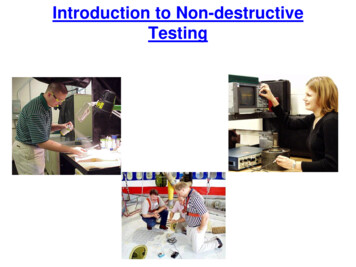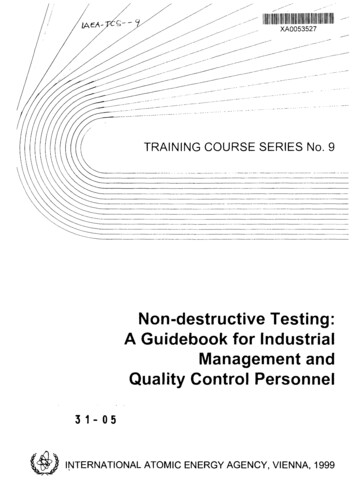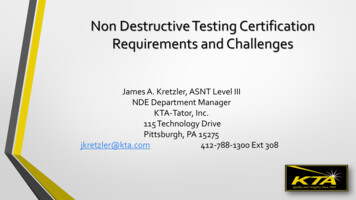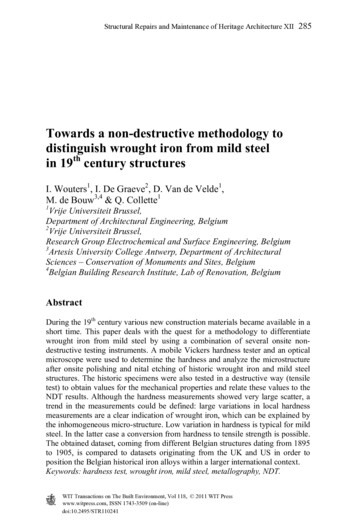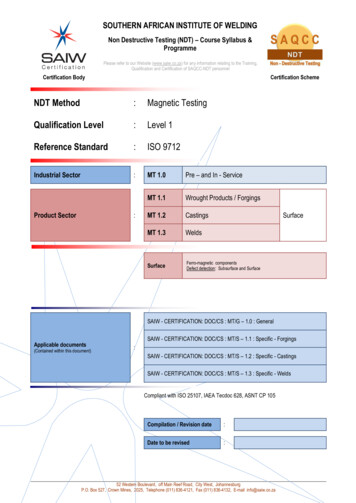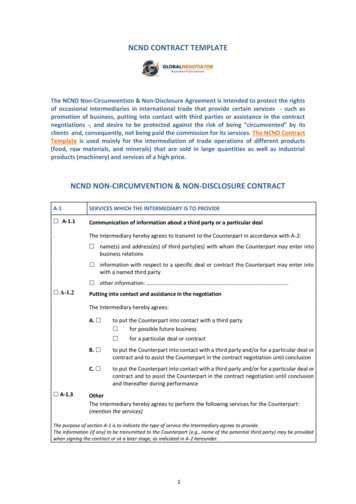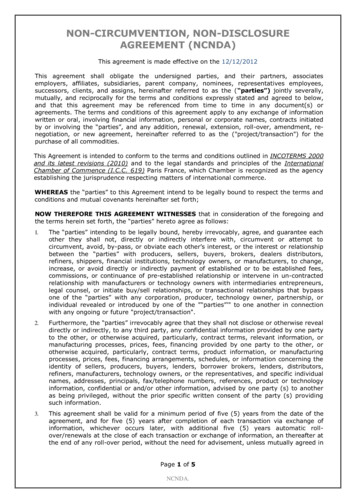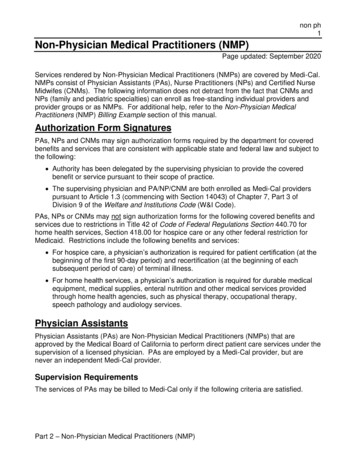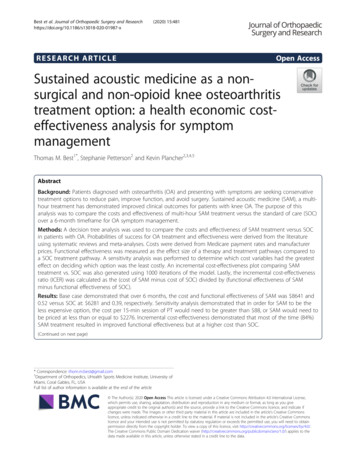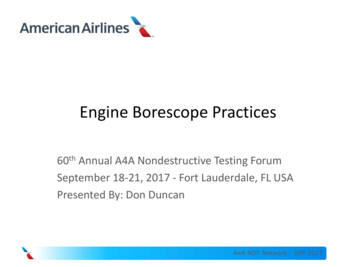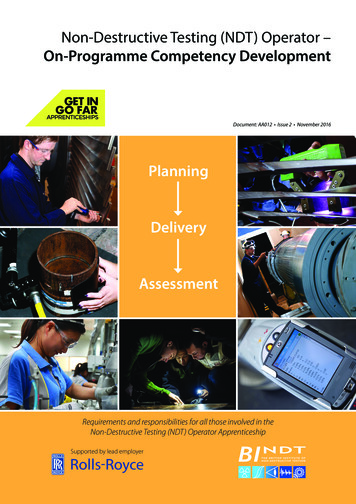
Transcription
Non-Destructive Testing (NDT) Operator –On-Programme Competency DevelopmentDocument: AA012 Issue 2 November 2016PlanningDeliveryAssessmentRequirements and responsibilities for all those involved in theNon-Destructive Testing (NDT) Operator ApprenticeshipSupported by lead employer
Non-Destructive Testing (NDT) Operator – On-Programme Competency DevelopmentContentsOverview of the Apprenticeship Scheme. 31.Introduction. 42.Apprenticeship Rationale. 43.Apprenticeship Development Process. 44.3.1NDT Operator Apprenticeship Standard. 43.2Assessment Plan. 43.3Managing the Apprenticeship. 5Apprentice’s Responsibilities.54.1Preparation. 54.2Foundation Stage. 64.2.1 NDT Project. 64.2.2 Knowledge and Skills. 74.2.3 Experience (Supervised Practice) On-the-Job Training. 84.2.4 Behaviours. 84.2.5 Activities to be carried out before completing the apprenticeship. 94.35.Preparing for the End-Point Assessment. 9Employer’s Responsibilities. 105.1Pay and Conditions.105.1.1 Paying the Apprentice.105.1.2 Conditions.105.1.3 Apprentices and Redundancy.105.1.4 Making an Apprenticeship Agreement.105.1.5 Apprenticeship Training Agencies.105.2Managing the Apprenticeship.115.2.1 Starting an Apprenticeship.115.2.2 Identification of Key People.115.2.3 Initial Considerations.115.2.4 Ongoing Activities and Commitments.125.2.5 Preparing for the End-Point Assessment.126.The Mentor. 137.The Lead Provider and NDT Training Provider. 138.The Independent Assessment Organisation. 139.The Professional Body. 1410. Quality Assurance Assessors. 1511. Occupational Competence of Key Officers. 151
Non-Destructive Testing (NDT) Operator – On-Programme Competency Development11.1 Independent Assessment Organisations.1511.2 The Professional Body (BINDT).1511.3 Lead Providers.1611.4 NDT Training Provider.1611.5 Employers.1611.6 Mentors.1611.7 Supervisors of On-The-Job Training (Supervised Practice).1611.8 Company Internal Audit.1611.9 Independent Assessment Organisation’s Internal Audit Assessors.1612. Glossary. 1713. References . 1714. Appendices. 18Appendix 13 Description of NDT Methods.18Appendix 14 A list of other Technical and Safety Modules.20Appendix 15 Apprenticeship Completion Checklist.21Appendix 16 UK-SPEC Competency Matching Form for EngTech Registration.22Appendix 17 Employer’s Appraisal Checklist.25Notes. 262
Non-Destructive Testing (NDT) Operator – On-Programme Competency DevelopmentOverview of the Apprenticeship SchemeNon-Destructive Testing (NDT) OperatorRecommendedOn-Programme ContentNDT Training Provider AssessmentBasic NDT awareness and principlesProduct technologyHealth & safetyKnowledge of one NDT methodSkills required for one NDT methodSpecific supplementary and alignedknowledge associated with the NDT methodEmployer’s Briefing and ReviewCodes of conduct, behaviours and companymethodologyEmployer to create and assign an NDTprojectQuarterly checks on progressKey:Lead Provider AssessmentEmployer AssessmentEnd-Point AssessmentGatewayEmployer’sFinal ReviewEnd-Point Assessment(carried out by the independent assessment organisation)Review of Portfolio of Evidence and AchievementsDetermine thatthe NDT Level 2qualification hasbeen completedDetermine thatthe knowledgerequirementsstipulated in thestandard havebeen metDeterminethat the skillsrequirementsstipulated in thestandard havebeen metDetermine thatthe behaviourrequirementsstipulated inthe standardhave beenmet3Carry out a review of all evidence and achievements,including mapping the outcomes to the requirements ofthe apprenticeship standard. Review course attendance,end-of-course test, examination results, log bookof on-the-job training, CPD, awards, certificates andemployer’s reports and assessments. The review of theportfolio of evidence and achievements will be tested atthe observational interview (professional discussion).Observational Interview (Professional Discussion)Carry out a synoptic interview to ensure that theapprentice has achieved all aspects of the apprenticeshipstandard. This will include all technical requirements,behaviours and health & safety. Challenge the evidenceprovided in the ‘Review of Evidence and Achievements’.Project Showcase – Presentation of NDT ProjectThe apprentice will give a comprehensive presentation ofthe NDT project. The presentation will establish that theproject, which has been designed to encompass as manyrequirements of the apprenticeship standard as possible,has been completed and that the requisite knowledge andskills have been achieved.
Non-Destructive Testing (NDT) Operator – On-Programme Competency Development1. IntroductionThis document explains the rationale for the development of the Non-Destructive Testing (NDT) Operator apprenticeship. Itdescribes the process of how the scheme has been developed and, most importantly, it defines the responsibilities for thoseparticipating in the scheme.Non-destructive testing (NDT) is a mechanism used by engineers to detect defects in materials and structures, either duringmanufacturing or while in service. Typically, the methods used are ultrasonic, radiography, magnetic particle, eddy current,dye penetrant, infrared thermography and visual methods. These methods are available when the employer chooses whichmethod to include within the apprentice’s programme.2. Apprenticeship RationaleEvery day, more than 25,000 inspections are carried out in factories and on-site in the UK to detect defects and damage ina huge range of products, plant and structures; it is estimated that there are more than 120,000 NDT inspectors operatingworldwide.Historically, the career path to becoming an NDT Operator was by transferring from another industry sector, in some casesfrom a related engineering discipline, or from a completely unrelated industry. Rarely did peopl
The NDT operator apprenticeship standard has been developed by a Development Group, which includes 40 to 50 leaders in the NDT industry. 3.2 Assessment Plan The NDT operator assessment plan is a mandatory document that has been approved by the Minister of State for the Department of Business, Innovation & Skills and the Department for Education. The assessment plan details ‘what’, ‘by whom’

